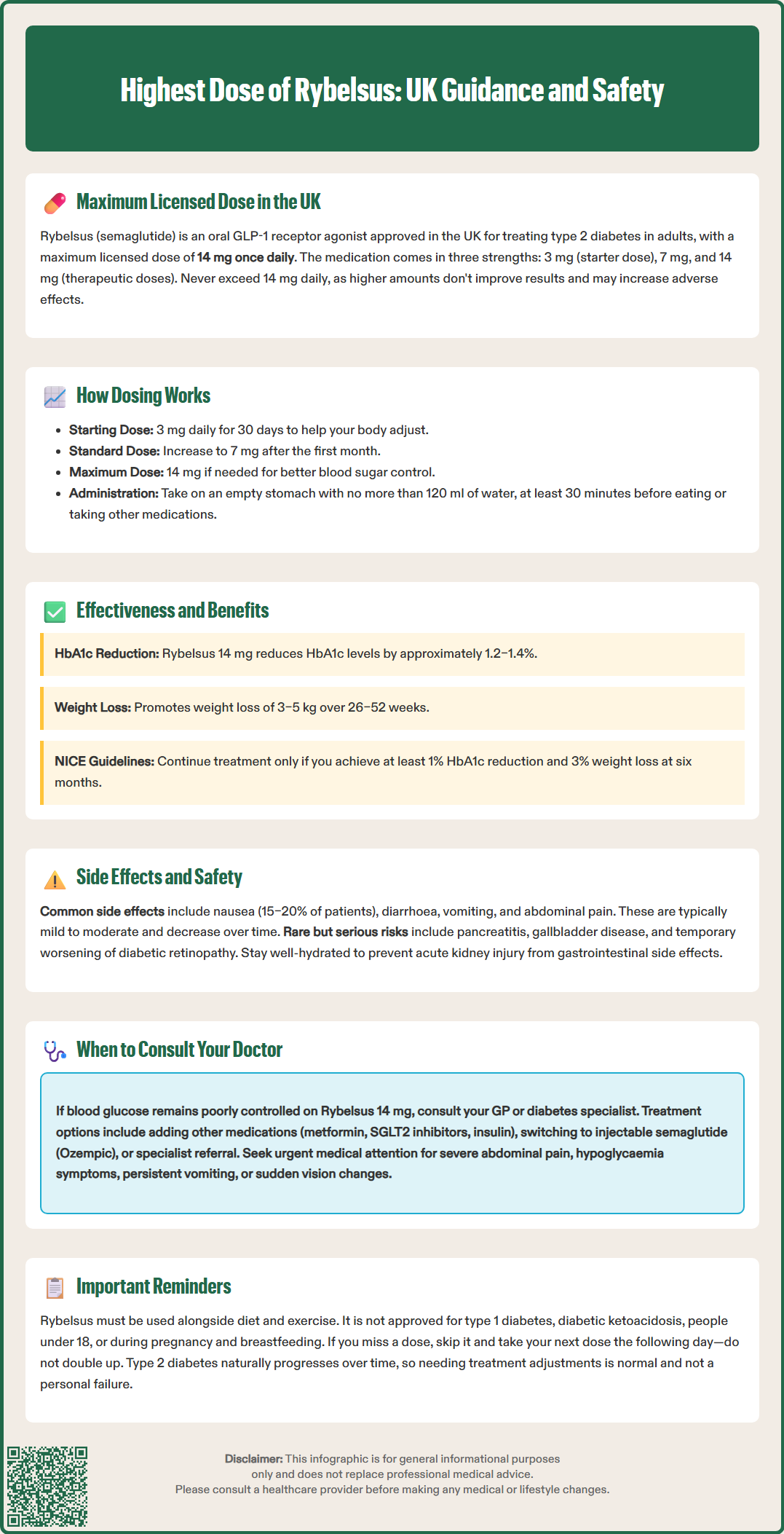
Rybelsus (semaglutide) is an oral glucagon-like peptide-1 (GLP-1) receptor agonist licensed in the UK for treating type 2 diabetes mellitus in adults. The highest dose of Rybelsus available is 14 mg once daily, representing the maximum licensed strength for improving blood glucose control. This medication is available in three tablet strengths—3 mg, 7 mg, and 14 mg—with dosing carefully escalated to balance efficacy with tolerability. Rybelsus must be used alongside diet and exercise as part of comprehensive diabetes management, either as monotherapy when metformin is inappropriate or in combination with other glucose-lowering medications. Understanding the maximum dose and proper dosing schedule is essential for safe, effective treatment.
Quick Answer: The highest dose of Rybelsus available in the UK is 14 mg once daily, which is the maximum licensed strength for treating type 2 diabetes mellitus in adults.
Rybelsus (semaglutide) is an oral medication licensed in the UK for the treatment of type 2 diabetes mellitus in adults. It belongs to a class of medicines called glucagon-like peptide-1 (GLP-1) receptor agonists. The highest dose of Rybelsus currently available and licensed for use in the UK is 14 mg once daily.
Rybelsus is available in three tablet strengths: 3 mg, 7 mg, and 14 mg. The 3 mg dose is not intended for glycaemic control but serves as a starting dose to help patients tolerate the medication and minimise gastrointestinal side effects. The therapeutic doses are 7 mg and 14 mg, with the 14 mg tablet representing the maximum licensed dose for improving blood glucose control in people with type 2 diabetes.
It is important to note that Rybelsus should be used as part of a comprehensive treatment plan that includes diet and exercise. The Medicines and Healthcare products Regulatory Agency (MHRA) has approved Rybelsus for use either as monotherapy when metformin is inappropriate or not tolerated, or in combination with other glucose-lowering medications when existing treatment does not provide adequate glycaemic control.
Patients should never exceed the 14 mg daily dose. The dosing schedule is carefully designed to balance efficacy with tolerability, and taking more than the prescribed dose does not improve outcomes and may increase the risk of adverse effects.
Rybelsus is not indicated for the treatment of type 1 diabetes or diabetic ketoacidosis. It is also not recommended for use in people under 18 years of age, during pregnancy, or while breastfeeding. If pregnancy is planned or occurs, treatment with Rybelsus should be discontinued.

Rybelsus follows a step-wise dose escalation regimen designed to improve gastrointestinal tolerability whilst achieving optimal glycaemic control. This gradual approach is essential because GLP-1 receptor agonists commonly cause nausea, vomiting, and other digestive symptoms, particularly when treatment is initiated or doses are increased.
The standard dosing schedule is as follows:
Starting dose: 3 mg once daily for 30 days. This initial dose allows the body to adapt to the medication and is not sufficient for blood sugar control.
First increase: After 30 days, the dose is increased to 7 mg once daily. Many patients achieve adequate glycaemic control at this dose.
Maximum dose: If additional blood sugar control is needed after at least 30 days on 7 mg, the dose may be increased to 14 mg once daily.
Rybelsus must be taken on an empty stomach with no more than 120 ml of water, at least 30 minutes before the first food, drink, or other oral medications of the day. The tablets must be swallowed whole and should not be split, crushed, or chewed. This specific administration requirement is crucial because food significantly reduces the absorption of semaglutide from the gastrointestinal tract.
If a dose is missed, the missed dose should be skipped, and the next dose should be taken the following day. Patients should not take an extra dose or increase the dose to make up for the missed dose.
The gradual dose escalation serves two important purposes: it minimises gastrointestinal side effects and allows healthcare professionals to assess the patient's response at each dose level. Some patients may achieve their glycaemic targets on 7 mg and may not require escalation to the maximum 14 mg dose. The decision to increase to the highest dose should be made collaboratively between the patient and their healthcare team, based on HbA1c levels, tolerability, and individual treatment goals.
No dose adjustment is required for patients with renal or hepatic impairment, although experience in patients with severe impairment is limited. It is important to maintain adequate hydration during treatment, especially if experiencing gastrointestinal side effects, to prevent dehydration and potential acute kidney injury.

Mounjaro® is the most innovative GLP-1 medication proven to dramatically curb appetite, hunger, and cravings to help professional men achieve substantial weight loss.
Start Here
Wegovy® is a weekly injectable GLP-1 medication with proven effectiveness in reducing appetite, hunger, and cravings to help busy professionals lose significant weight.
Start HereClinical trial data demonstrates that Rybelsus 14 mg provides superior glycaemic control compared to lower doses. In the PIONEER clinical trial programme, which included over 9,500 participants with type 2 diabetes, the 14 mg dose achieved greater reductions in HbA1c (glycated haemoglobin) levels compared to the 7 mg dose, with mean reductions of approximately 1.2–1.4% (13-15 mmol/mol) from baseline.
Beyond glucose control, Rybelsus 14 mg has been associated with clinically meaningful weight loss, with patients typically losing 3–5 kg over 26–52 weeks of treatment. This dual benefit of improved glycaemic control and weight reduction is particularly valuable for people with type 2 diabetes, many of whom are overweight or obese.
Common adverse effects at the 14 mg dose include:
Nausea (occurring in approximately 15–20% of patients)
Diarrhoea
Vomiting
Decreased appetite
Abdominal pain
Constipation
These gastrointestinal symptoms are usually mild to moderate and tend to diminish over time as the body adjusts to the medication. However, they are more frequent at the 14 mg dose compared to 7 mg.
Serious but rare risks include pancreatitis, diabetic retinopathy complications (particularly in patients with pre-existing retinopathy), and gallbladder disease including cholelithiasis and cholecystitis. Patients should seek medical attention for persistent severe upper abdominal pain, which may radiate to the back, with or without vomiting, or if jaundice develops.
People with pre-existing diabetic retinopathy should be monitored closely, as rapid improvement in glucose control may be associated with temporary worsening of retinopathy. Patients should seek urgent medical advice if they experience sudden changes in vision.
Dehydration resulting from gastrointestinal side effects can potentially lead to acute kidney injury. Patients should maintain adequate fluid intake, especially if experiencing vomiting or diarrhoea, and seek medical advice if these symptoms persist.
In animal studies, semaglutide caused thyroid C-cell tumours, but the human relevance of this finding is uncertain.
According to NICE guidance, GLP-1 receptor agonists like Rybelsus should be continued only if there is a beneficial metabolic response, typically defined as a reduction in HbA1c of at least 11 mmol/mol (1%) and weight loss of at least 3% of initial body weight at six months, where these criteria are applied.
If you experience any side effects, talk to your doctor, pharmacist or nurse. This includes any possible side effects not listed in the package leaflet. You can also report side effects directly via the Yellow Card Scheme at yellowcard.mhra.gov.uk or search for MHRA Yellow Card in the Google Play or Apple App Store.
If you are taking Rybelsus 14 mg and your blood glucose levels remain inadequately controlled, it is essential to consult your GP or diabetes specialist rather than attempting to adjust your medication independently. Inadequate glycaemic control is typically defined as an HbA1c level above your individualised target, which may be 48 mmol/mol (6.5%) for those on medications not associated with hypoglycaemia, or 53 mmol/mol (7.0%) for those on sulfonylureas or insulin. However, targets are often personalised based on individual circumstances.
Your healthcare team will first assess several factors that may be affecting your diabetes control:
Medication adherence: Are you taking Rybelsus correctly (on an empty stomach, 30 minutes before eating, swallowing tablets whole)?
Lifestyle factors: Diet, physical activity, weight, and alcohol consumption
Concurrent medications: Some drugs can affect blood glucose levels
Intercurrent illness or stress: These can temporarily worsen glycaemic control
If Rybelsus 14 mg alone is insufficient, NICE recommends several treatment intensification options:
Adding another oral agent: Metformin, SGLT2 inhibitors, sulfonylureas, or pioglitazone may be combined with Rybelsus
Adding basal insulin: This combination can be highly effective for patients requiring greater glucose-lowering
Switching to injectable semaglutide: The subcutaneous formulation (Ozempic) achieves higher drug levels and may provide superior glycaemic control
Reviewing overall diabetes management: Including referral to specialist diabetes services for complex cases
It is important to note that Rybelsus should not be combined with DPP-4 inhibitors or other GLP-1 receptor agonists. For patients with established cardiovascular disease, heart failure, or chronic kidney disease, SGLT2 inhibitors may be particularly beneficial as add-on therapy.
It is important to recognise that type 2 diabetes is a progressive condition, and many patients will require treatment intensification over time. This does not represent treatment failure but rather the natural evolution of the disease. Regular monitoring through HbA1c testing (typically every 3–6 months) allows timely adjustment of therapy.
When to seek urgent medical attention:
Persistent severe abdominal pain (possible pancreatitis or gallbladder disease)
Symptoms of hypoglycaemia if taking Rybelsus with sulfonylureas or insulin
Signs of diabetic ketoacidosis (excessive thirst, frequent urination, confusion)
Unexplained weight loss or persistent vomiting
Sudden changes in vision
Your diabetes care should be individualised, and decisions about treatment changes should always be made in partnership with your healthcare team, taking into account your overall health, preferences, and treatment goals.
No, 14 mg once daily is the maximum licensed dose of Rybelsus in the UK. Exceeding this dose does not improve outcomes and may increase the risk of adverse effects.
It takes at least 60 days to reach the 14 mg dose, starting with 3 mg for 30 days, then 7 mg for at least 30 days before escalating to the maximum dose if needed.
Consult your GP or diabetes specialist for treatment intensification options, which may include adding another oral agent, basal insulin, or switching to injectable semaglutide.
All medical content on this blog is created based on reputable, evidence-based sources and reviewed regularly for accuracy and relevance. While we strive to keep content up to date with the latest research and clinical guidelines, it is intended for general informational purposes only.
DisclaimerThis content is not a substitute for professional medical advice, diagnosis, or treatment. Always consult a qualified healthcare professional with any medical questions or concerns. Use of the information is at your own risk, and we are not responsible for any consequences resulting from its use.